Open and inclusive science:A Chinese perspective
Wei Yang
Zhejiang University,China
Abstract The open science campaign has attracted worldwide interest in academia and funding agencies,largely due to a recent policy statement by UNESCO.The momentum is fuelled by the inclusive nature of scientific research.This study focuses on the topological and dynamic quantification of open and inclusive science as measured in the appropriate dimensions,proposing that the domain of open and inclusive science may be enlarged by balancing the gains and responsibilities of the major stakeholders for knowledge generation and communication.The guiding principles for harmonious engagement in this domain are postulated.The current status of open and inclusive science in China is reviewed based on an array of statistics,which indicate that China is emerging as an important partner in this worldwide endeavour.The current barriers in China’s development of open and inclusive science are delineated,and possible pathways to circumvent those difficulties are outlined.
Keywords Open science,inclusive science,Chinese approach
1.Introduction
The first wave of the open science movement was launched by European researchers (Boulton et al.,2011;Chan et al.,2002) and associated funding agencies.The wave was well received by major publishers worldwide,and it led to the progressive implementation of open-access (OA) publishing.The developing countries welcomed the endeavour but had reservations based on the potential economic burden.The academic community commonly believed that open science could increase the reliability of scientific knowledge and enlarge the scope for researchers to access that knowledge.
Competing views exist.Arguments are raised concerning the interplay between open data and intellectual property protection;the global,national,regional,corporate or private incentives for scientific research;extremes of knowledge sharing;and investment in research by individuals or collaborations.Such controversies make open science a multifaceted,complicated and rather delicate issue.
The role of China is instrumental for global engagement in open science.A recent news report inNature(Schiermeier,2018) seemed to suggest the willingness of both the government and the research institutions of China to adopt Plan S for immediate OA (European Science Foundation,2018) and support‘a(chǎn) wide range of flexible and inclusive measures to achieve this goal’.That news report seemed rather upbeat or even misleading on this rather delicate issue.The endorsement by the National Natural Science Foundation of China(NSFC) was,to a certain degree,ceremonial,and thus the funding agency voiced moral support for a move towards immediate OA.The actual march towards a viable plan for immediate OA for mainstream academic publications will be a long one.There are several hurdles visible on the horizon.
The situation received a dramatic boost in 2021,when UNESCO circulated the first draft of a policy document on open science (UNESCO,2021).A panel discussion on‘open science and its impact on scientific knowledge sharing and management’was organised by the China Association for Science and Technology (CAST) on 9 July 2021 to explore the Chinese position regarding open science.The 2021 Blue Book,which is a collection of annual data for Chinese periodicals,focuses on policy developments concerning open science,supplemented by the viewpoints of several academic leaders in China (CAST,2021a).
In a dialogue on 28 July 2021 between young scientists in China and top world experts (CAST,2021b),a common understanding was reached:An open and inclusive approach would be beneficial for global collaboration on scientific research and knowledge sharing.This study is based on such an understanding and presents the necessary supporting data.
2.Dimensions for open and inclusive science
Suitable dimensions are needed to quantify the scope of open and inclusive science.This article proposes a manifold approach consisting of twin sub-spaces to characterise the topological and dynamic aspects of open and inclusive science,respectively (Figure 1).

Figure 1.Twin sub-spaces portraying the dimensions of open and inclusive science.(a) Topological dimensions and quadrants;(b) Dynamic dimensions and drivers of knowledge chains.
The first sub-space addresses topological features in two dimensions:the openness and the inclusiveness of scientific knowledge.Those dimensions are in contrast to the closeness and the exclusiveness of scientific knowledge,and they emphasise the common knowledge of humanity in discoveries,inventions and communications.If presented in a plane,as shown in Figure 1(a),the abscissa would measure the openness of the research data or the willingness to share the data,while the ordinate would measure the willingness to share research incentives.The value of‘openness’ranges from negative (closed) to positive (open),passing through various categories:confidential data,data under patent protection,data transferable upon intellectual property purchase,limited sharing,a need for round-robin verification,open to the public,active encouragement for citations,and promotion to the public.The value of‘inclusiveness’ranges from negative(exclusive)to positive(inclusive),passing through various categories:strictly private exploration,free and private exploration,team exploration,organised research,collaborative research,research dedicated to regional interests,research dedicated to the national interest,and global science for major challenges.
Four quadrants appear in the topological plane.The first quadrant signifies collaborative research from which data is freely shared.The term‘global science’,as used by Suresh (2011,2012),serves as an example for this quadrant.It engages the major challenges faced by humanity and is motivated by the common good of the people,as addressed in a commentary by Luo (2021).
The second quadrant represents collaborative research from which data is not shared with people outside the collaboration.The term‘organized research’ describes this quadrant.Inclusiveness may involve an institution,an enterprise,a region or a nation.An example of national inclusiveness would be strategic research (such as tasks in national laboratories) with possible farreaching effects on the development of a nation.Research institutes confront strategic challenges via collaboration,and their objectives are competitive with rival institutes.The data obtained is commonly regarded as a corporate or national secret and is often heavily protected.
The third quadrant covers non-collaborative research,the data from which is not shared with competitors.The term‘private research’describes endeavours in this quadrant.Studies are conducted for private interests and are generally driven by potential profits or personal well-being.This quadrant does not form part of open and inclusive science.
The fourth quadrant consists of individual research,the data from which is shared with the public.The term‘blue-sky research’ is appropriate for this quadrant,in which the research is curiositydriven and deals with challenges faced by humanity.
Issues of scientific literacy,public engagement and responsibility in science (Reddy,2021) are basic requirements for all research in all four quadrants,irrespective of the quadrants’ openness and inclusiveness.
The second sub-space describes the dynamic aspect of open and inclusive science,represented in two dimensions:the height and the value of the scientific knowledge,as shown in Figure 1(b).The two dimensions resemble potential energy and internal energy in the thermodynamic sense.The vertical axis measures the position (or the height,or the potential,or the generality) of the specific scientific knowledge in the knowledge chain.Its value ranges from positive to zero (the ground),passing through various categories from the basic to the applied.The value dimension,on the horizontal axis,measures the rareness and value of obtaining the data,along with the value-added aspect of its applications.Its value ranges from zero (useless knowledge) to positive.The assignment of value considers the following factors:(1)capital and workforce investment,(2) the reliability of the research data,and (3) the potential to make a profit.
Figure 1(b) depicts the dynamics of knowledge transmission chains in eight possible directions.Direction 1 refers to‘generalization’:the value of the data is enhanced by interdisciplinary transfer,while the height of the data remains unchanged.Direction 2 refers to‘synergy’:the value of the data is enhanced by interdisciplinary cross-linking,while the height of the data is raised by the effects of synergies.Direction 3 refers to‘a(chǎn)scending’:the value of the data is unchanged,while its content is upgraded to a new level.Direction 4 refers to‘overstatement’:the height of the data is improperly raised,and the value of the data is impaired,as frequently occurs when researchers use unnecessary jargon.Direction 5 refers to‘duplication’:the height of the data remains unchanged,while the value of the data is diluted by duplication.Direction 6 refers to‘downslide’:the value of the data is damaged by trivial duplication,while the height of the data is reduced by the loss of its rarity.Direction 7 refers to‘a(chǎn)pplication’:the value of the data is unchanged,while the application of the data lowers its height,symbolising a process of application from upstream to downstream.Direction 8 refers to the pursuit of an‘innovation chain’:the height of the data gradually descends,while its value is enriched.
Open and inclusive science aims at(1)increasing the value of knowledge,(2) linking innovation chains,and (3) enlarging the shared knowledge of humanity.The dynamics leading to progression in directions 1,2,3,7 and 8 are beneficial in such endeavours.Directions 1,2 and 8 serve to increase the value of knowledge,while directions 7 and 8 are aimed at the application of scientific knowledge and the linkages of innovation chains.Directions 2 and 3 raise the levels of scientific knowledge,thereby enlarging common knowledge.The dynamics in directions 1,2,3,7 and 8 can be facilitated by open and inclusive science through repeated citations,research collaborations and knowledge transfer.
3.Stakeholders
The processes of open and inclusive science are dictated by the stakeholders who participate in the generation,cultivation and propagation of scientific knowledge.In the traditional route,scientific knowledge originates from authors (data generators);the creation of the data is supported by funding agencies(data investors);the data is presented by publishers(data operators);and collected by librarians (data presenters);and,finally,it reaches readers (data receivers).When scientific knowledge is received,its readers are likely to become authors,pursuing another loop in scientific progress.In the era of open and inclusive science,the openness (measured by access to scientific knowledge) and the inclusiveness(measured by the average numbers of co-authors and citations) become higher,and the knowledgespreading cycle becomes faster.Nevertheless,the stakeholders are still authors,readers,publishers,librarians and funding agencies.The elimination of librarians from this information chain would make the process fragile and unstable.
For stable open and inclusive science,the newly gained rights and duties of the five stakeholders must be balanced.In 2016,at a Global Research Council (GRC) annual meeting in the Netherlands,an analysis was presented on the interests of the five stakeholders concerned in the OA scheme and issues of balanced gains and duties were raised and identified as a win–win situation (Yang,2016).
Readers are strong advocates for a broader openness regime in which they have the right to read scientific and technical literature promptly,free of charge,and without responsibilities.This asymmetric situation provides an incentive for OA.However,an imbalance may emerge if support from the nation is absent.
In open and inclusive science,authors gain more cross-references and citations,simultaneously avoiding double dipping.However,when authors are not funded by research grants,they face the threat of continuous increases in article processing charges (APCs).It is also against the principle of fairness for researchers to contribute while assuming all the publishing costs.The Chinese scientific community recently discussed the excessive growth of APCs for OA papers (Cheng and Ren,2016).Opinions differ about contributions versus citations,fame versus economic gain,and individualism versus institutional regulations.
If librarians’ affiliated institutions convert their subscription fees to APCs,they will no longer have a sense of ownership of the research data in their libraries,even if their institutions pay as much as before.They may face a crisis threatening the value of their work.The interplays between budget savings and institutional presence,knowledge sharing and ownership,service and job security do not seem to favour librarians.
For publishers,although the OA system is financially less robust than the subscription model,there is the temptation to move ahead of their competitors in the new era of data operation.This era is characterised by four shifts:a shift in the operation model(from publication to data operation),a shift in the business model (from subscriptions to APCs),a shift in the sale model (from hybrid to transformative),and a shift in the presentation model (from article arrays to data packages).
The partial role of the funding agencies (along with the institutions that run libraries) in supporting publication costs will change to a full role in supporting publication.In practice,they continue to assume the main portion of the financial burden in generating scholarly output.Meanwhile,for the NSFC,the assigned funds for publishing may double or triple.Although this is not a decisive factor,it will require a transition period of up to 10 years to absorb the increased costs.
4.Guiding principles
OA is generally considered to exist in several forms.‘Gold’ OA refers to immediate OA without any embargo period.‘Green’ OA refers to OA that has certain embargo period (such as one year).‘Diamond’ OA refers to the Gold OA without APCs.‘Hybrid’ OA refers to a mixed type of OA form in which both OA articles and subscription articles are covered.
In the context of global gold OA,how best to share APCs becomes a sensitive issue.In order to avoid double-dipping,European institutions have proposed converting the business model from journal subscriptions to OA in such a way that the subscription fees can be covered through APCs.The NSFC endorsed theAction Plan towards Open Access to Publicationsin Berlin for green OA (GRC,2013).The scholarly publishing world is on the verge of a profound conversion.The conversion will highlight open and inclusive science.The success of the conversion relies on the following guiding principles.
Political acceptance.The global change from a subscription model to an OA model should not discriminate against academic publications in any country.It should be noted that this sensitive issue is not without its online critics.Steps need to be taken to safeguard researchers who do not have grants to pay for their APCs.The other aspect of political acceptance lies in cultural awareness.The OA movement should be free of language bias.The English language should not have a monopoly or excessive dominance.A good multilingual translation platform is a desired outcome.
Economic viability.There are different perceptions of the NSFC statement,as quoted in a news report inNature(Schiermeier,2018).One perception is that‘the APC for the OA model should cost about the same as the subscription fees would cost’.Another perception is that‘the APC for the OA model should cost about the same as the subscription fees in the respective country would cost’.A large price difference (maybe by a factor of 3) exists between those two interpretations (for example,subscription fees in China started from the fee base of a developing country).Therefore,the NSFC would support the second interpretation.(The actual wording in the NSFC position paper is:‘We demand that publishers should not increase their subscription prices on the grounds of the transformation from subscription journals to OA publishing.We require that standard and transparent mechanisms are set up with caps on APCs when we allow the funded projects to use their grants for publishing in OA journals.’)There is a need for a coordinated way to narrow the gap in subscription fees.
Transparency and fairness.All policies and milestones for the conversion from the subscription model to the OA model should be transparent and verifiable.Fairness here has two pillars.First,the conversion should be fair to all countries and regions.Second,the conversion should be fair to all stakeholders(readers,authors,publishers,librarians and funders).
Participation and control.All countries and all stakeholders involved in the conversion should participate in this process.China,as a major partner in advancing science and technology,should be in a driving position in the core process of this endeavour.It would be beneficial if China could be included in the pilot projects.The tight schedule implied by Plan S (European Science Foundation,2018) could provoke resistance.Any negative reaction could jeopardise the whole process.The process should begin with a smooth,well-controlled timetable.
5.Status in China
5.1 Growing scientific publications
China has been moving swiftly on all quantitative measures concerning scientific publications.The country has enjoyed particularly fast growth in scholarly output,which grew by 20% per year from 1981 to 2007.Since 2007,the annual growth rate has slowed to 9%.Those trends are shown in Figure 2(a).The gear shift in growth rate happened along with an emphasis on quality that began in 2007(Yang,2021a).
A beneficial aspect of the slowdown in the growth rate of scholarly output from China’s mainland has been a decline in its relative retraction ratio,as shown in Figure 3,which shows chronological data for relative retraction rates (the retraction ratio in a country divided by the world average).The red curve gives the variation in China from 1996 to 2020.The peak occurred in 2010,coinciding with the year of degree awards following the year of the slope shift in Figure 2(a) (Yang,2021a).Chang and Yang(2021)gave a heuristic explanation by correlating the data in Figure 2(a) with data for degree awards in the same time period.It is also evident that a peak of retraction occurs in a country during its model transition for science development:for China in 2010,Japan in 1998,Germany in 1994,and the US and UK in much earlier years.
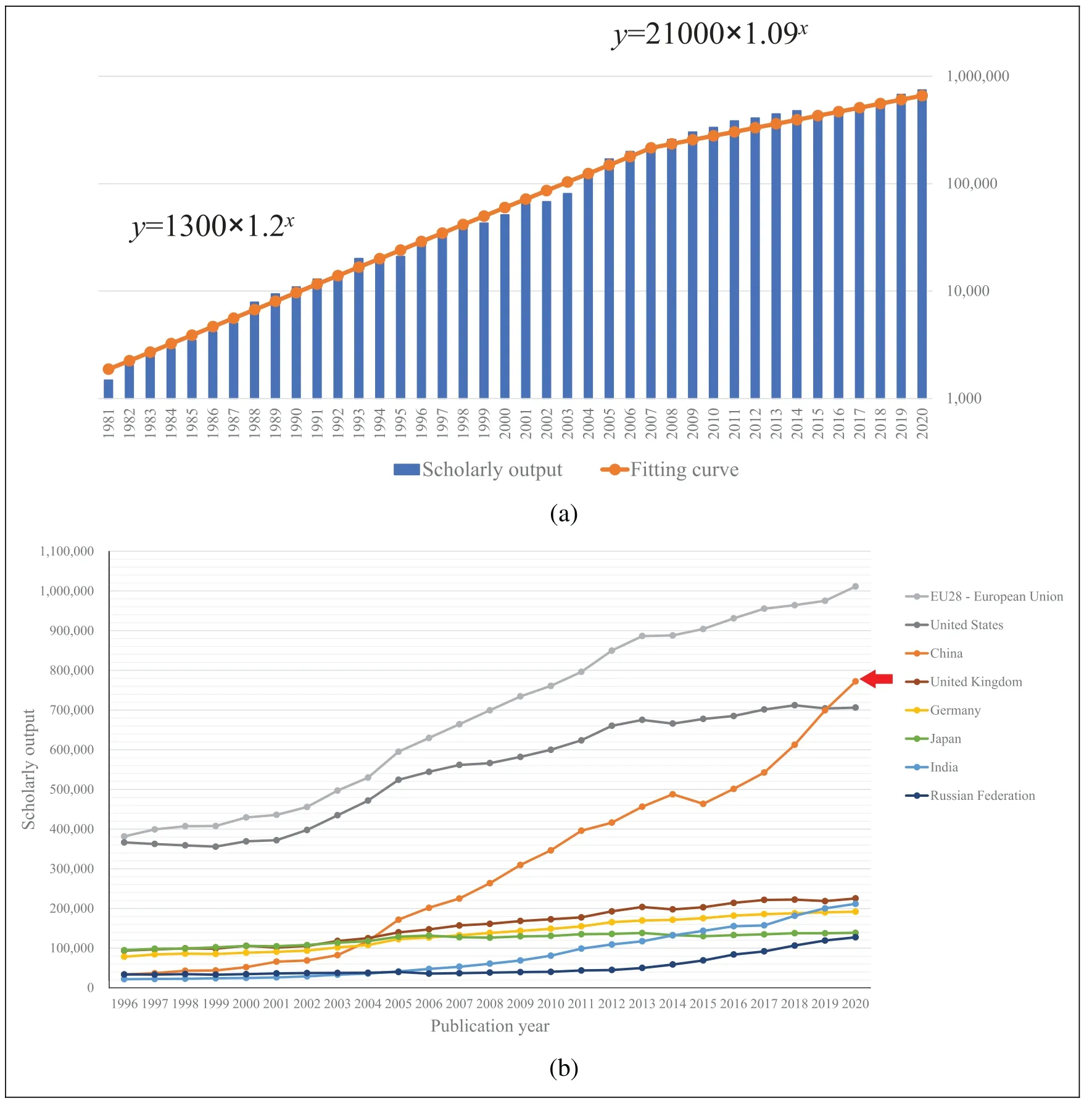
Figure 2.Rapid growth of scholarly output from China’s mainland.(a) Statistics indicating a bilinear annual growth(20%and 9%)trend(data source:Scopus);(b)Comparison of the major global contributors(data source:Scopus/SciVal,accessed 1 November 2021).
China’s mainland currently ranks number one in 10-year accumulated scholarly output in seven disciplines (mathematics,physics,chemistry,engineering,materials,computer sciences and agriculture)of the 22 categories of essential scientific indicators(ESIs).The scholarly output from China in 2020 was comparable with that of the US and the EU28(28 countries of the European Union),as Figure 2(b)shows.
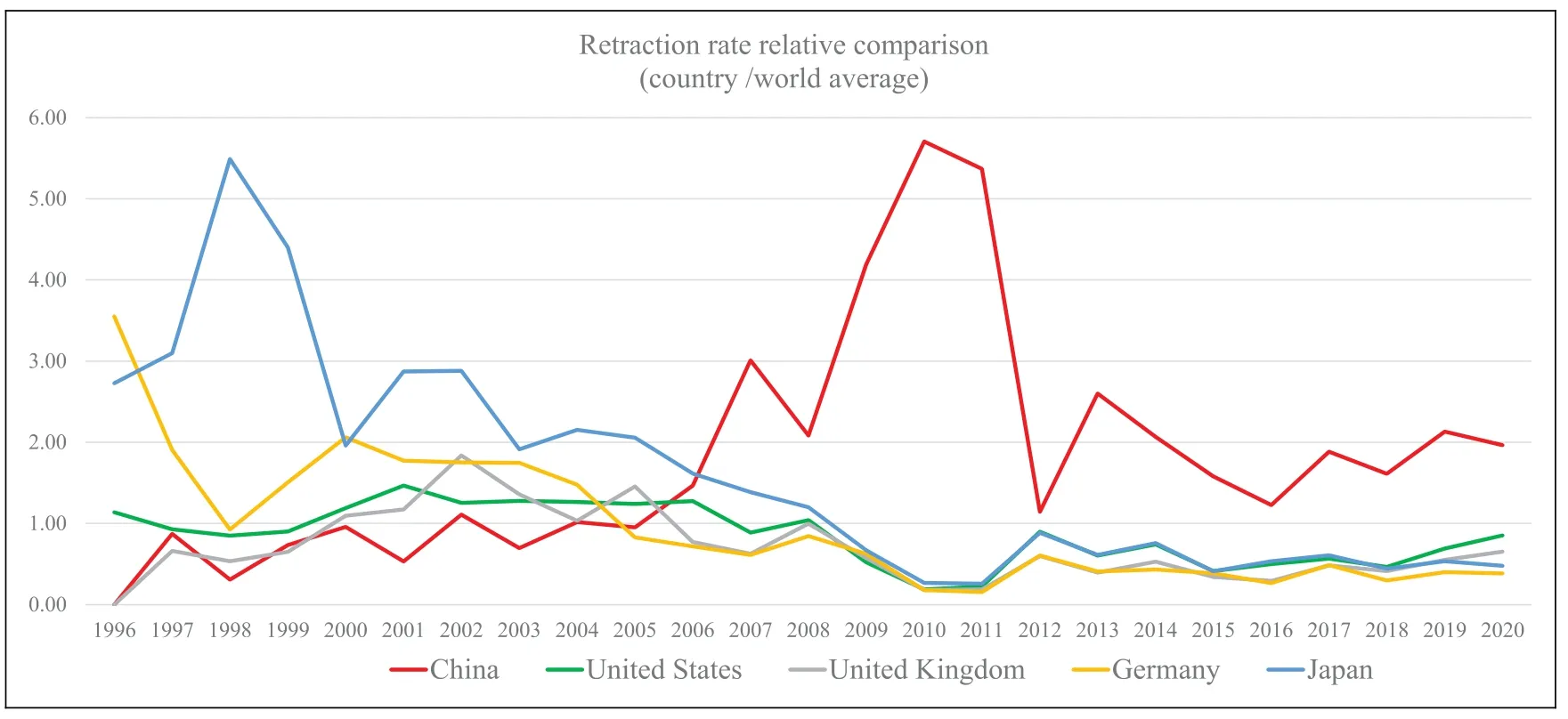
Figure 3. Relative retraction ratios in China,the US,the UK,Germany and Japan (data source:scopus/sciVal,retraction watch,accessed 9 September 2021).
Equally impressive is the growth of the academic impact of China.ESI data indicates that China’s mainland currently ranks number one in four categories(chemistry,engineering,materials and computer sciences) for 10-year accumulated academic impact.Along with the rapid growth in scholarly output,a gradual increase in academic quality has been observed,as Figure 4 shows.Field-weighted citation impact gradually rose from the 1996 value of 0.37(meaning 37% of the world average) to the 2020 value of 1.14.That last value is marginally higher than the world average,but it is still low compared to the UK,US,German and European Union (EU)values.
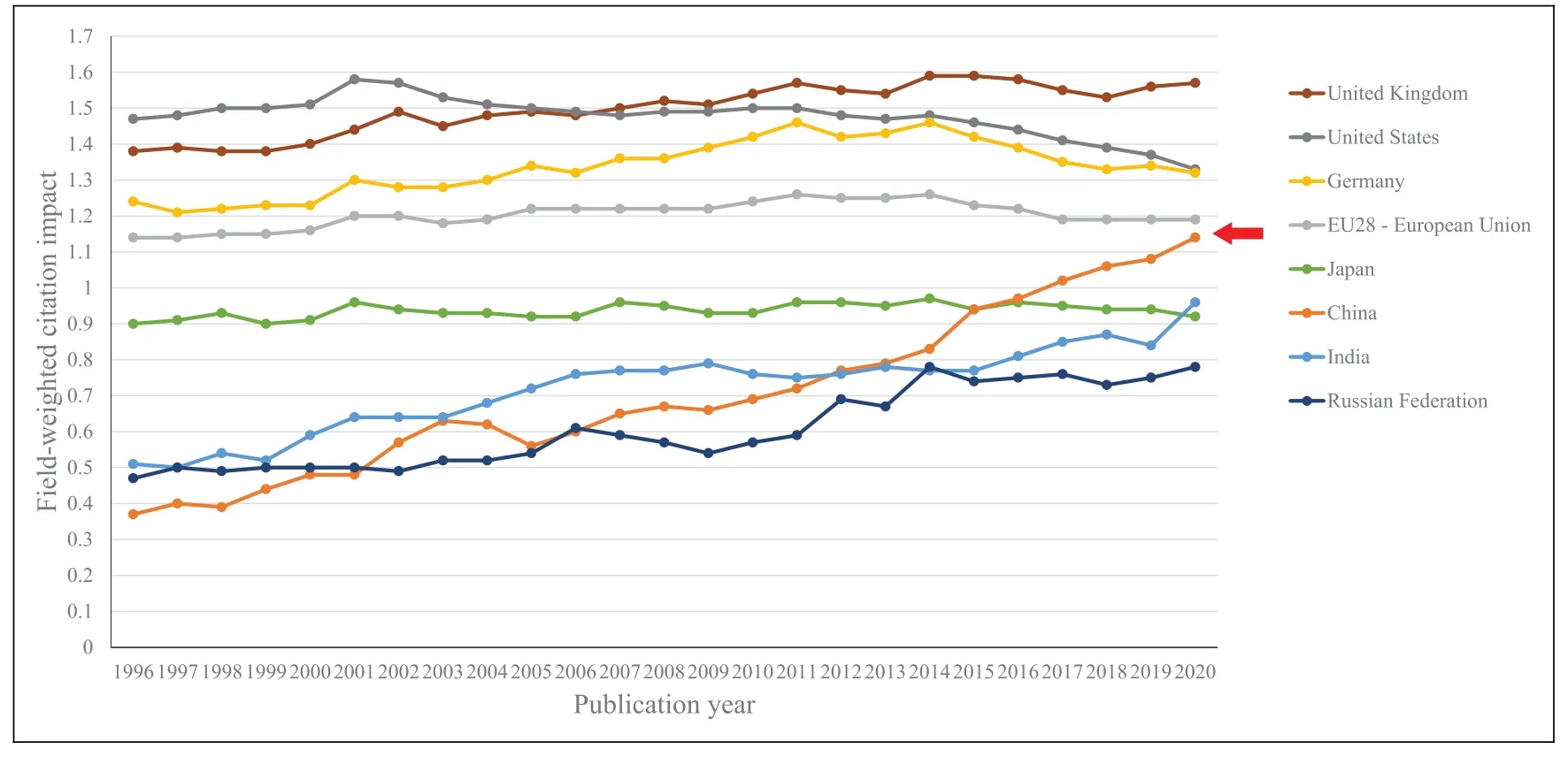
Figure 4. Gradual increase in academic quality of scholarly output from China(data source:scopus/sciVal,accessed 1 November 2021).

Figure 5. Percentiles of top 1% cited articles;the rapid rise in contributions from China is apparent (data source:Scopus/SciVal,accessed 1 November 2021).
The rapid rise in the number of highly cited articles from China’s mainland is even more impressive.Figure 5 shows the rapid growth in the percentiles of cited articles from China in the top 1%,rising from slightly over 0.2% in 1996 to almost 2% in 2020.China has become a significant presence contributing to high-end world knowledge,having twice the average global rate for highly cited articles.The status of China as a major partner that contributes substantially to world research literature has been firmly established.
5.2 Publication of OA articles
Figure 6 summarises the relevant status of OA articles.Among all OA articles(in gold OA journals and hybrid journals) annually,worldwide,US contributions declined gradually from 44% to 17%,EU contributions rose steadily from 28% to 38%,and contributions from China surged from 1% to about 20% in the past 25 years.Open science in China,while behind the European level,has flourished at about the same pace as the development of scholarly output.
The numbers of OA articles in China,the US,the EU and the world are shown in Figure 7(a).In addition to the exponential growth trend,the importance of the contributions from China is evident.Figure 7(b) shows the compositions of gold OA and hybrid OA publications.It is clear that a large proportion of OA articles from China are in gold OA,while a sizeable number of OA articles from the EU are in hybrid OA.
5.3 The situation of inclusive science
A useful measurement of inclusiveness is the percentage of international collaborations divided by the total number of publications.Figure 8 shows that set of data.There is a gradual,but not sufficiently high,increase in the percentage of collaborative work from China from the 1996 level of 15%to the 2020 level of 23%.That level is much lower than the UK 2020 level of almost 60%,but slightly higher than the levels for the Russian Federation and India.The BRICS countries (including Brazil,Russia,India and China) still have a long way to go in their progress towards inclusive science.
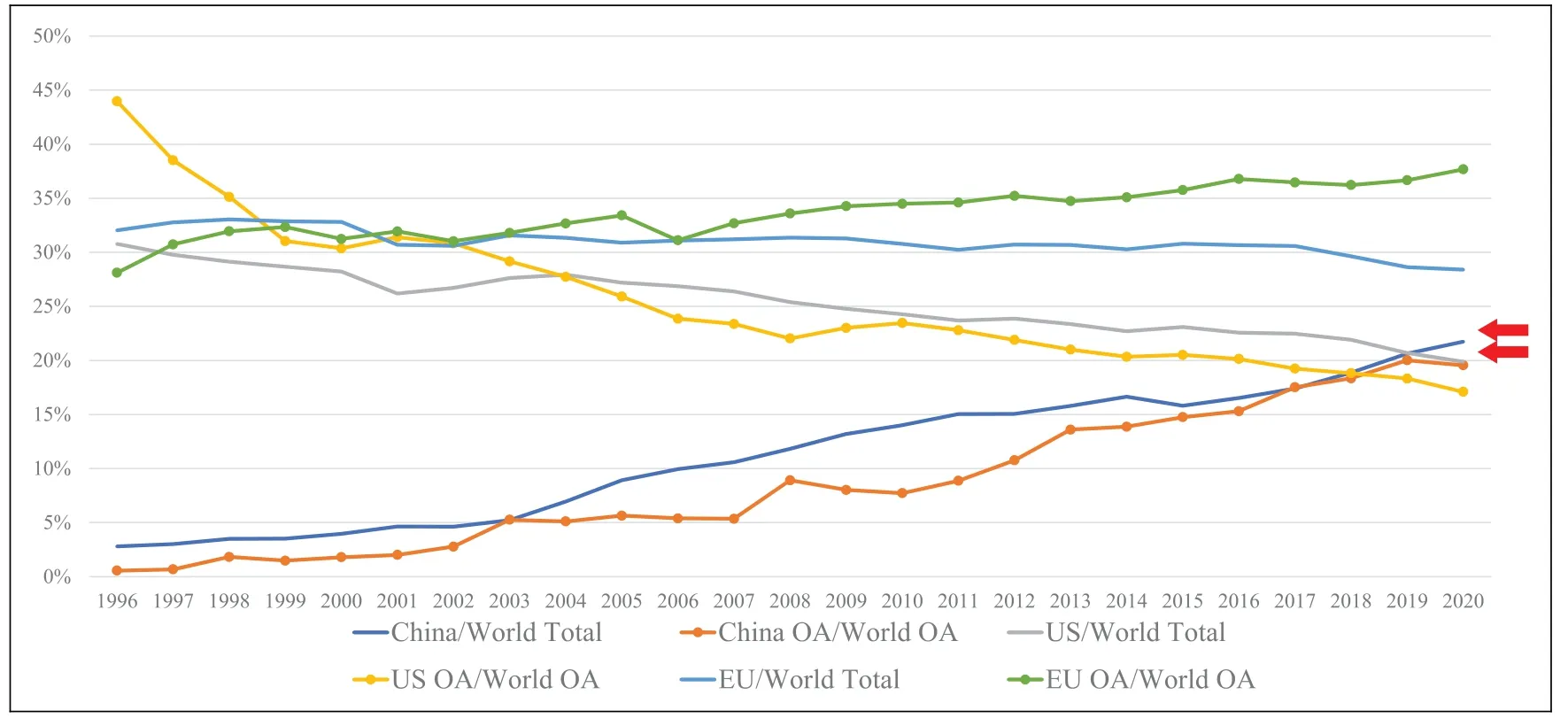
Figure 6. Variations in the shares of total and OA articles from China,the US and the EU(data source:Scopus/SciVal,accessed 5 September 2021).
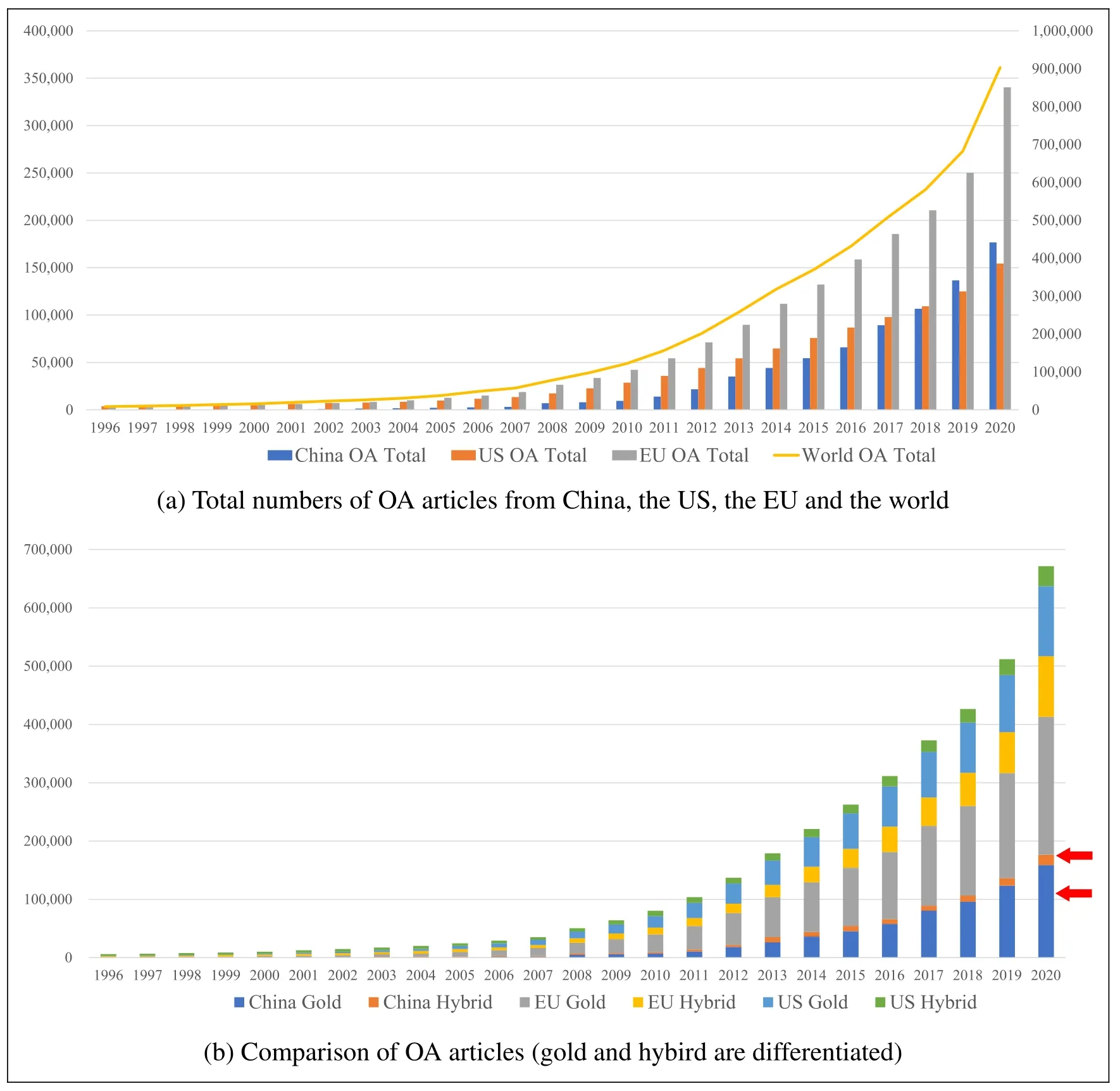
Figure 7.Comparison of OA articles contributed by China,the US,the EU and the world(data source:Scopus/SciVal,accessed 5 September 2021).
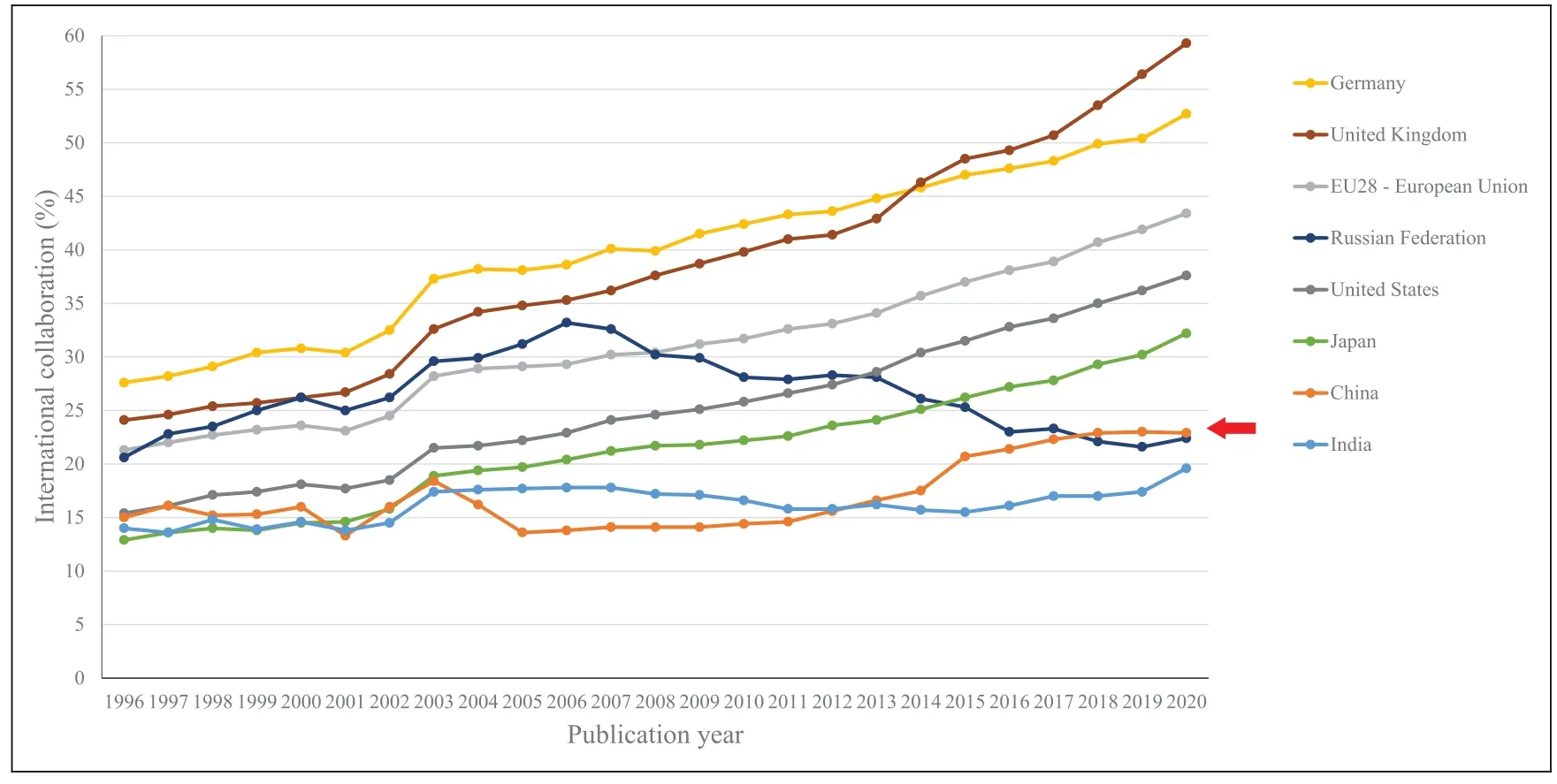
Figure 8.Improvement in the percentage of international collaboration from China (data source:Scopus/SciVal,accessed 1 November 2021).
6.Barriers to the development of open and inclusive science in China
The journey towards global open science seems to have passed a point of no return,but obstacles remain worldwide,and the situation in China’s mainland remains unsettled.Academics in China accept open science at a conceptual level,but their practical engagement is hindered by four barriers.One barrier concerns the reputation of OA journals,while the others relate to the practical enforcement of open science in China.
The first barrier lies in the low academic reputation of OA journals within academic circles in China.Statistics indicate that the average impact factors of the OA journals in which Chinese scholars publish their research are lower than those of the regular subscription journals.Surveys by Cheng and Ren(2008,2016)revealed a bipolar distribution in which the high end was focused on OA‘megajournals’ (such asNature Communications,PLoS OneandScientific Reports) and the lower end (75% of total volume)was focused on less reputable OA journals.This barrier is gradually dissolving due to the following advances:(1) world-renowned academic journals such as theNature Researchseries are currently on the transformative path from hybrid to complete OA;(2) arising from the citation advantage of OA,the top Chinese research journals,such as those supported by the flagship Chinese STM(science,technology and medicine) journals programme,are adopting a development strategy via diamond OA to boost their citations;and (3) a blacklist of predatory journals has been prepared to help authors and funders to avoid low-quality journals (Cyranoski,2018).
For the practical enforcement of open science in China’s mainland,the remaining three barriers are:(1) the absence of a national consortium in China that can work with international publishing groups to settle the costs and rights for its readers and authors;(2)the gap between the current subscription costs in China’s mainland and the average international costs;and (3) the absence of a clear pathway for STM journals in China to continue their development under a global OA conversion.A possible approach to circumvent these three barriers seems to be emerging,and the issues are examined one by one in the following section (see also Yang,2021b).
7.Approach to eliminate barriers to the development of open and inclusive science in China
7.1 Establishing a library consortium
As has been mentioned,five stakeholders co-exist in the era of open and inclusive science.Many past agreements between libraries in China and international publishing groups (such as Elsevier and Springer Nature) were facilitated by CALIS (the China Academic Library and Information System).The strategy was to sign a consortium agreement with the international publisher partner to subscribe to selected data resources.The agreement might include an IP (internet protocol) range that could access the subscribed data and a framework for the price limits of the subscription.For example,CALIS signed an agreement with Elsevier on the subscription cost in China’s mainland.The agreement,valid up to 2035,states that the subscription price would start from a low level suitable for a developing country,rising gradually and reaching 80% of the global mean by 2035.The consortium represents many libraries in China,and each library uses its institutional resources to purchase STM services within the price framework negotiated by the consortium.Each institution pays its share of the subscription and acquires the subscribed journals and digital resources in its libraries.
Under the OA model,an individual library no longer holds the published data (the data is in the cloud).In the absence of verifiable ownership,the libraries’motivation to purchase that data is evaporating.So,with whom can an international publisher discuss business involving reading and publishing rights under the OA model? There are at least four possible choices.The first is to rely on the authors to provide APCs for publishing their works under the OA model.However,it would seem unfair for researchers to contribute while assuming all the publishing costs.The second choice is to engage with each institution regarding reading and publishing packages—a negotiation route that would be long and difficult.The third choice is to negotiate with an alliance of funding agencies (such as the NSFC)to pay the conversion costs for the country or region,as is the case in the Netherlands.In the past,the NSFC has supported a huge number of scholarly outputs.As Figure 9 shows,the number of publications,either in total or only in OA,supported by the NSFC is unparalleled worldwide.
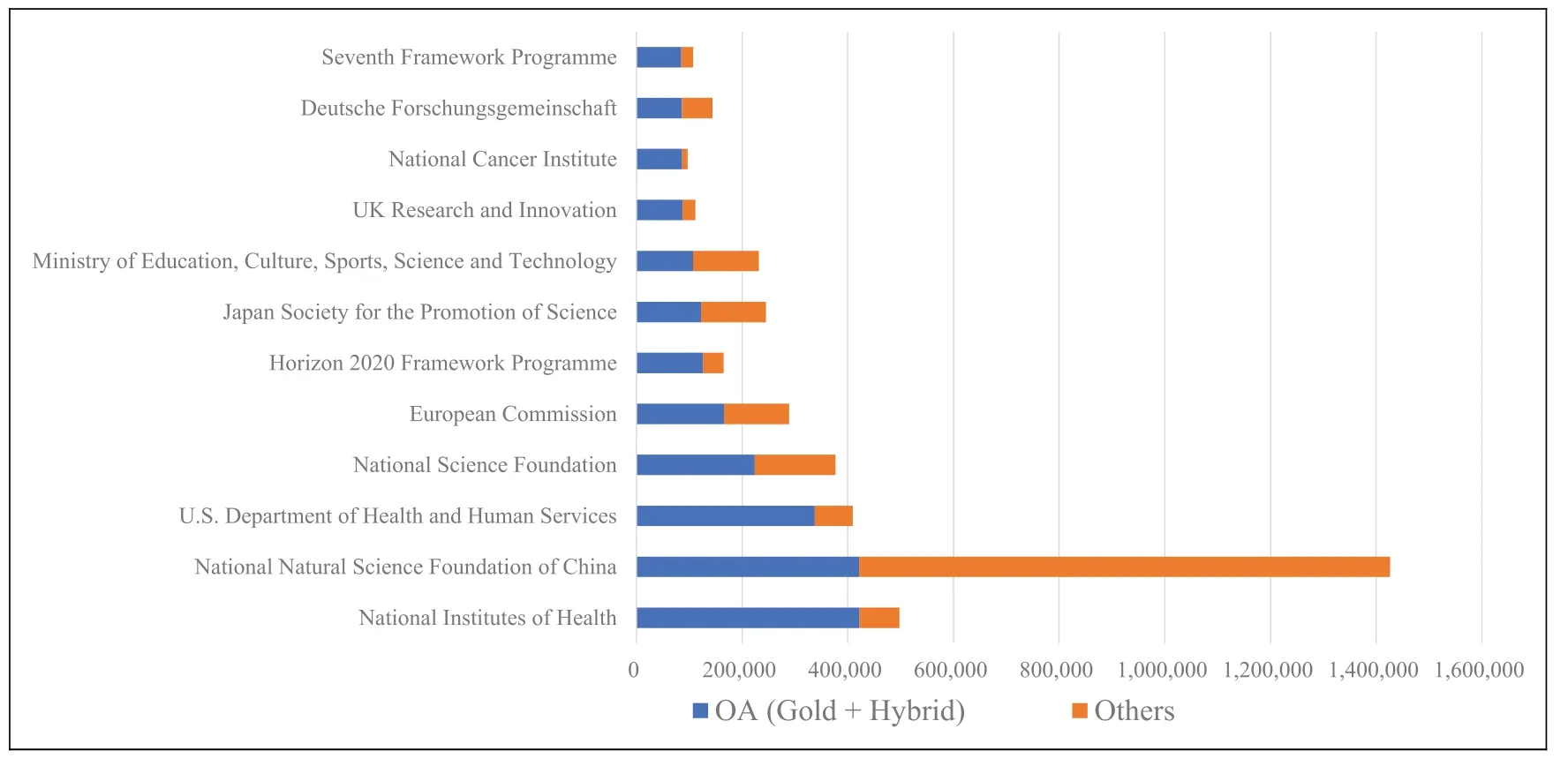
Figure 9.Number of publications(2016-2020)supported by major funding agencies in the world(data source:scopus/SciVal,accessed 7 September 2021).
The fourth choice is the more likely one.The CALIS consortium could discuss the reading and publishing rights for its affiliates (specified by a range of IP addresses)that the consortium represents.The scientific knowledge in the cloud could be accessed from those addresses,and the authors from the covered affiliates could also have the right to publish in a defined number of publications (a set number of APC waivers under a mutually agreed formula).CALIS could continue to use the price framework already negotiated with various publishers to pay their present subscription costs.Furthermore,the consortium could operate under the umbrella of nongovernment organisations such as CAST,which supervises STM development in China,and state-owned organisations such as the China National Publications Import and Export (Group) Corporation (CNPIEC),which handles most imports and exports of publications in China.Those two organisations could set up a foundation to support this business arrangement,with endorsements from enterprises and the government to support international exchanges.
7.2 Closing the gap between China’s subscription costs and the international average
China’s development has been so fast that previous cost predictions for global publications cannot keep pace with the rise in China’s international share of published data.The total subscription costs from China (6% to 10%,according to various estimates)are considerably lower than its percentage share of published data (21.7% in 2020,according to Figure 6).If all the authors in the world used the same APC standard,Chinese authors collectively would have to pay considerably more (maybe twice as much) than the amount the country currently pays under the subscription model.The cost difference under the OA business model is a barrier to China’s acceptance of the proposed open science strategy.That might be the reason that the Ministry of Science and Technology and the Ministry of Education issued a policy that sets a cap on APCs if they are paid from government funds.
This considerable difference cannot be absorbed in a period of a few years.A possible solution could be found in the following:(1)the total number of APCs for an institute or a country(when dealing with a consortium) should start with the current subscription cost;(2)an annual increment plan could be negotiated that would be similar to the one reached by CALIS and Elsevier for the period to 2035;(3) additional increases(which might be supported by a foundation jointly launched by CAST and CNPIEC) could be negotiated for enlarged publishing rights;(4) the authors in China’s mainland who are not covered by the consortium could pay for their individual APCs;and (5) the nations/regions in the world could be divided into different categories for different APC rates.The country/region categories of the World Bank could be adopted for that purpose.The value of gross domestic product per capita (or R&D per capita)could serve as a measure to adjust APCs.
7.3 Finding a development path for Chinese STM journals in the context of OA publication
A final barrier is the need to transform the regional Chinese STM journals system into the OA model.There are 5000 STM journals based in China,belonging to 4000 legal entities.Among them,only 1000 or so are on the journal platforms of international publishers.With the global publishing business model changing from subscription to OA,the remaining 4000 journals would be severely affected.All authors belonging to the institutions covered by the consortium could seek to publish their works on the journal platforms that sign agreements with the consortium.Those journals would be more influential and more reputable,and would be free of APCs.The expected decline of the remaining 4000 journals would strengthen resistance to open science in China.
One advantage of including CAST and CNPIEC in OA publishing is that they are planning to set up a foundation that will endorse domestic STM publications.The foundation will have two goals:(1)support the consortium for the reasonable additional costs involved in the subscription–OA conversion;and (2) support selected domestic STM journals to progress towards the OA model.The advancement of the flagship Chinese STM journals programme promoted by a CAST-led council has resulted in a development landscape for the restructuring of STM journals in China taking shape.Accordingly,evaluation metrics for the 5000 STM journals in China could be constructed.Based on the evaluation,a priority list for the national open science data repository could be proposed.The group-purchase deal of this repository with the library consortium could proceed,following the path of similar deals with international platforms for scientific knowledge.
A‘road map’ could be devised to promote open and inclusive science in China.The conversion process from the subscription model to the immediate OA model would take 5 to 10 years.A primary task is to establish elaborate and technologically advanced platforms for the operation of scientific knowledge.Currently,several leading publishing houses in China have started their transition to a multifunctional research literature common ground.The top functions include:(1)a journal platform;(2)a scientific knowledge base(with its tailor-made and characteristic data collection);(3)analytic metrics;and(4)a global publication,distribution and marketing network.The platform should be built by professional informatics and analytics teams that are capable of platform operation with TensorFlow computation,enormous databases,and sophisticated application task groups.The platform should possess comparable data acquired by open science means.It could assemble multidimensional service packages and be reputable and credible among scholars.It would be beneficial for Chinese platforms to collaborate with well-established international peers,such as Elsevier and Springer Nature.The joint development of the publication firms and digital science enterprises is the key to increasing the momentum for the transition to OA.
We need a well-thought-out plan that incorporates the interests of the various stakeholders.The possible approach suggested in this study addresses the participation of the library consortium,a CAST/CNPIEC-supported foundation,and a funding agency such as the NSFC,so that support for a spectrum of gold OA services can be launched.The change in the business model of domestic STM journals could be considered in a similar way.The composite price tactics could be adapted to cover the basic needs and the additional benefits of open science.The CAST/CNPIEC-supported foundation could be used to establish national strategic support for open and inclusive science,operated by the national fund,and endorsed by society as a whole.
Acknowledgements
The author is grateful to Ms Xiaoling Kang for providing all data exported from Scopus/SciVal,as well as the graphic presentations of that data.Special thanks are given to Dr Hui Luo for suggesting the topic of this study.Stimulating discussions with my colleagues and friends,such as Dr Helena Yang from Deep-Tech,Dr Shuai Yan,previously at Springer Nature,and Dr Shengli Ren of Science Press,are much appreciated.Gratitude is also given to Dr Jinpeng Huai,who encouraged me to engage in the issue of open science.
Declaration of conflicting interests
The author declared no potential conflicts of interest with respect to the research,authorship and/or publication of this article.
Funding
The author received no financial support for the research,authorship and/or publication of this article.

